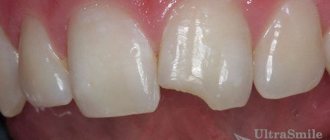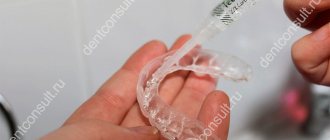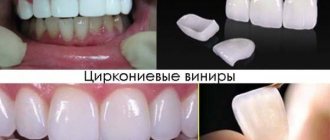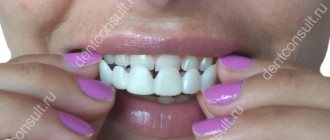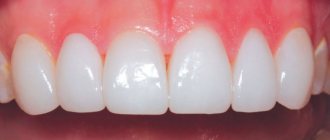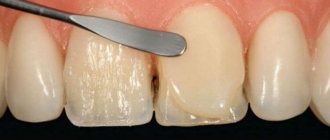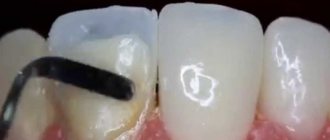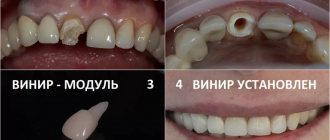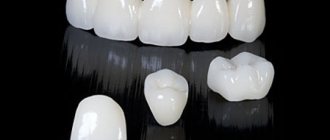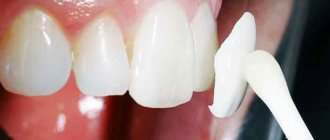To understand which veneers to choose, ceramic or composite, let’s take a closer look at what dental veneers are and what their features are. Veneers are thin plates of ceramic (sometimes zirconium) or composite material that are fixed to the front side of the teeth. Such microprostheses are used to correct aesthetic defects of the dentofacial apparatus and provide additional protection to the enamel. The onlays, made from impressions, imitate the natural shade of the dentition and do not stand out from it.
Veneering straightens the dentition, hides defects (uneven teeth, large interdental gaps, cracks or chips of the coronal shell), simplifies oral hygiene, and serves as an effective means of preventing periodontal diseases.
Author of the article: Meliksetyan Daniel Oganesovich
Work experience:
15 years
Specialization:
Dentist-orthopedist
Works:
at the clinic on Proletarskaya metro station
Types of veneers
Microprostheses are divided into composite and porcelain. Composite ones are divided into:
- Direct
Made in the patient's mouth. Installation technology: the doctor grinds the coronal shell to a thickness of 0.3-0.7 mm and forms an overlay layer-by-layer from a material identical to that used in filling. The procedure is completed by grinding and polishing the surface of the microprosthesis. In part, the technique has something in common with artistic dental restoration.
- Indirect (componers)
They are made in a dental laboratory (like ceramic analogues). Impressions are taken from dental units prepared for restoration, from which thin plates are made using computer equipment. They have an increased precision of fit to the enamel surface. This guarantees a long service life of orthopedic structures.
When wondering which veneers are better to choose, composite or ceramic, you should first understand the features of the options. Each type has its own advantages and disadvantages in terms of aesthetics, reliability and price.
Pros and cons of ceramic veneers
The advantages of silicon oxide overlays are obvious:
- Lack of ability to oxidize, change color, or degrade. Ceramic veneers do not absorb pigments from food and do not disintegrate under the influence of acids and alcohols. They will not show any stains or discoloration throughout their entire service life.
- Ceramic veneers will last for more than a decade if initially installed correctly and handled with care.
- The plate is very durable, despite its microscopic thickness, not reaching even a millimeter.
- Imitation of enamel is the best among other veneering techniques.
Flaws:
- The cost of ceramic veneers is not affordable for every patient.
- The impossibility of quick prosthetics sometimes becomes extremely difficult. A person will have to visit the clinic at least twice: to take impressions and for final installation. In addition, you will have to spend money on making a temporary structure, which will need to be worn until the permanent veneers are glued.
- When preparing teeth for veneers, the doctor may overheat the tooth pulp, which can lead to inflammation and acute toothache.
Porcelain veneers require grinding down of the teeth. Composite veneers do not have high strength and durability. There is a better alternative to all options: install veneers without grinding your teeth Luxneers
Composite veneers: indications, contraindications, advantages
In most cases, composite onlays are installed using the direct method in one visit. The doctor applies the filling material layer by layer and photopolymerizes each layer.
Indirect composite onlays require several visits to the doctor. The prepared tooth is etched with gel, an adhesive composition is applied, onto which the orthopedic plate is fixed.
Veneers from filling material are made in a laboratory if the installation is planned for more than 1-2 teeth. Laboratory plates are more durable.
Indications
- Minor unevenness.
- Microcracks, chips of the coronal shell.
- Gaps, enlarged interdental spaces.
- Darkening or discoloration of dental elements that cannot be whitened.
Contraindications
- Serious damage or defects to the enamel.
- Depulped teeth.
- Malocclusion.
- Pathological abrasion of the coronal shell.
- Dental diseases in the acute stage.
- Mobility of dental elements.
- Allergy to material components.
Advantages
- Time saving – direct restorations are performed in one visit to the doctor.
- Inexpensive.
- The variability of colors allows you to choose a material close to the natural shade of enamel.
- The composite is firmly fixed, and detachment of the restoration is avoided.
- Minimal preparation of the tooth surface.
Contraindications for installation
There are contraindications for installing veneers, which the doctor will identify after examining the condition of the oral cavity. The question is not about the skill of the dentist, but about the effectiveness and expediency of the procedure. You cannot install onlays if there is a dental problem that requires monitoring or is incompatible with the concept of veneers. The dentist’s task is to honestly tell the patient about the reasons he has discovered that prevent the procedure from being performed. Contraindications for installing veneers
from any material are:
- There are erosive changes in the enamel on the surface, as well as other defects that cannot be covered with veneers due to the impossibility of observing and treating them.
- Pathological abrasion of teeth, as well as their mobility.
- Impacted tooth.
- Dental diseases of teeth and gums, especially acute conditions. 5. Incorrect bite. 6. Bruxism.
- Poor hygiene.
- Bad habits (smoking, biting off hard objects).
- Short teeth.
- Pulpless teeth without nerves.
- Imperfect bite that can be corrected with orthodontic treatment.
- Participating in extreme or active sports that pose a risk of injury.
Ceramic veneers: indications, contraindications, advantages
Ceramic veneers are made in the laboratory using impressions. The pads are installed at your next visit to the doctor. Plates with a thickness of 0.2-0.3 mm can be installed without turning, and plates with a thickness of 0.5-0.6 mm require minor grinding of the enamel.
Dental ceramics are a stable material that retains its shine and shape for the entire period of use. It is not susceptible to aggressive substances, dyes, etc. A laboratory-created microprosthesis imitates the translucency and shade of natural enamel.
Indications for installation
- Change in the shade of the coronal shell due to endodontic treatment.
- Fluorose, tetracycline teeth.
- Large interdental spaces.
- Gummy smile.
- Weakened tone of the muscle-skin framework of the lower facial zone (installation of veneers on chewing teeth gives a lifting effect).
- Progressive abrasion of enamel.
- Thinning or damage to tooth enamel.
- Multiple restorations.
- Wedge-shaped defect, irregular shape or position in a row, shortened coronal part.
Contraindications
- Severe tooth decay.
- Common caries.
- Bruxism.
- Mobility of dental elements.
- Bite abnormalities.
- Gingivitis, periodontitis, periodontal disease
- Temporary dental units or after intensive fluoridation.
Advantages
- Optical reflective effect identical to natural enamel.
- Smooth, durable, impervious surface.
- Biocompatibility with periodontal tissues.
- Naturalness, aesthetics.
- Durability of structures.
- Minimal risk of developing caries at the junction of natural and artificial tissues.
Indications for restoration with composites
Why do you need compositers if you already have Cerinate veneers and lumineers? The question is reasonable. Indeed, veneers, lumineers, and componeers perform a similar function, but the latter have one conceptual difference - they are not created in the laboratory for each patient, but are offered ready-made. In this way they are similar to Lumineers, but are cheaper. The composite is made from a nanohybrid composite with the addition of ceramic filler. The material is pressed under high pressure, so the finished product is homogeneous and porous. Restorations come in many shapes and colors – choosing the best option for everyone is not difficult.
You can put compositors on your teeth if:
- cracks and minor chips of the front teeth;
- age spots and enamel erosion;
- increased abrasion of dental tissues;
- minor curvatures;
- crevices and interdental spaces.
Design differences
Composite
- Installed in one visit.
- The structure is looser, so over time the shade changes under the influence of food and drinks that have a coloring effect (tea, coffee, red wine, products containing dyes).
- It is necessary to polish systematically (at least once a year).
- The service life is 5-7 years, then an update is required.
Ceramic:
- Installation will require at least 2 visits to the doctor.
- Retains original color and shine throughout the entire period of use.
- Does not require professional care.
- The service life is 10-15 years.
Composite orthopedic plates are 2-3 times cheaper than porcelain ones.
Composite restoration techniques
Restoration with composite veneers has several techniques that are essentially similar.
Indirect composite veneers - compositors
Componeers, like direct composite veneers, are used to correct the color and shape of teeth. But they are made not according to individual casts, but according to templates, and are offered to the patient in finished form. The overlays, formed from extruded composite, are installed using the indirect method. The structure lasts 5 - 7 years. You can learn more about the methodology here.
Restoration with composite veneers instead of bleaching
Restorative bleaching, or lamination, is the application of a thin layer of composite to the tooth surface. Unlike restoration with composite veneers, plates only change the color of the teeth without affecting the shape.
Artistic restoration
The technique of artistic restoration involves the correction of dental surfaces with composites for chips, cracks, irregular shapes and other aesthetic defects. The technology is similar to installing composite veneers on teeth. However, the procedure is carried out in both the frontal and chewing areas. Filling also applies to this technique.
What to choose
The main advantage of composite restorations over porcelain structures is their lower price and the ability to reduce the time spent on their installation. However, this advantage can no longer be called relevant today, since technologies have appeared that make it possible to install ceramic overlays in a day.
Reviews from doctors and patients indicate that veneering eliminates dental defects, but composites are less able to imitate the natural shade and structure of the enamel. The disadvantage of composite onlays is their inaccurate fit to the tooth surface, which causes the accumulation of bacterial plaque, increasing the risk of developing caries and periodontal inflammation.
The choice of veneering type depends on the number of restorations planned, the need for additional treatment and other factors.
Composite veneers are an excellent solution for the restoration of 1-2 teeth. But if there are problems in the entire frontal area, it is better to install orthopedic ceramic overlays.
Flaws
And yet, despite all the listed advantages, composite veneers also have disadvantages, because of which many patients prefer to have ceramics installed.
- First of all, such linings are susceptible to color changes under the influence of external factors. So they may darken over time;
- The main disadvantage of composite veneers is their fragility, which significantly reduces their service life;
- Composite linings are subject to abrasion, and their surface cannot be polished to perfection;
- For longer use, the patient is recommended to follow a special diet, namely not to eat highly colored and very hard foods;
- It is not always possible to match the color of the composite to the natural color of the tooth, since the color palette is quite limited;
- There is a high probability of chips, cracks and the formation of defects along the edge of the plate;
- A lot in working with a composite depends on the doctor, since production occurs without the participation of special equipment.
You can get veneers on your teeth at a competitive price at Dentistoff Scientific Dentistry. Sign up!
Reviews
Sergey
Due to caries damage, a gap has formed on the front tooth. My dentist recommended putting a composite veneer on it. At first I was hesitant, but then the price tempted me. This procedure cost me 3500. The overlay has been in place for 9 years. Still intact. The only problem is that it has become dull and darkened. Now the tooth looks different.
Karena
There was a chip on the front tooth. The doctor disguised everything perfectly with a composite veneer, which lasted 6 years. When the tooth began to look very different from the rest over time, I decided to try a ceramic veneer. Now I think it’s better to immediately pay a good amount, but also get the best result.
Irina
Composite veneers are thicker in structure than ceramic veneers. Because of this, they will look unnatural from the very beginning. If such an overlay is made only on one or two teeth, then they will differ. This restoration solution is more suitable when you need to correct the entire row of front teeth.
Tatiana
I had composite onlays placed on my upper front incisors 3 years ago. So far I have no complaints. I don’t limit myself in food. I can eat a hard apple and crack the seeds. The color hasn't changed either. I believe that this method of tooth correction is the most suitable. And the price is affordable and the quality is good. Now I recommend it to all my friends.
Sources used:
- Northwestern State Medical University named after I. I. Mechnikov
- Zinovieva I.A., Zhuravleva M.G., Felker E.V. Bruxism as a pathological condition of the dental system
- Horn HR. “A new lamination, porcelain bonded to enamel.” NY St Dent J 1983
What is the price
As follows from the above, the cost of direct restoration is lower than the manufacture and installation of veneers from composite materials. The price of the procedure differs in different clinics and depends not only on the region. The cost of restoration directly depends on the status of the medical institution and the professionalism of the dentists.
Installation of composite veneers will cost more in Moscow clinics than in other regions of Russia.
If we are talking about economy-class dentistry, then the price for restoration with composite veneers will be in the range of 3,000 – 4,000 rubles per tooth.
In premium clinics, the cost of such a procedure can reach 16,000 rubles.
The higher the cost of installing a composite onlay, the better the quality of the restoration result and the professionalism of the dentist.
Cost of dental restoration in Leaderstom clinics
| Service | Price in rubles |
| Consultation | for free |
| Restoration of one tooth | 3500 |
| Composite veneer for 1 tooth | 7000 |
| Veneer E.Max | from 19000 |
| Cerec veneer | from 15000 |
| Lumineer installation | from 50000 |
| Zirconium dioxide veneer | from 40000 |
| Ultraneers | 45000 |
How long can composite veneers last?
The service life of these veneers is short and equal to five years. After this period, the veneers require their renewal. But even during the operational period, you will have to periodically visit the dentist to polish the product.
Read more about the disadvantages of veneers
Service time also depends on other factors. For example, careful daily hygiene procedures. In addition to toothpastes and a brush, you will need to use dental floss and an irrigator - a device that supplies water under pressure. This helps get rid of food debris and plaque in places that are hard to reach with a toothbrush.
The following operating rules will help extend the service life:
- Always monitors the condition of the gums in places where they come into contact with the lining. Discomfort and redness should serve as a signal to immediately visit a doctor.
- Promptly remove dental plaque, which provokes the development of caries. At the first suspicion of caries, the lining is removed in order to carry out appropriate treatment.
- Often, after installation of composite plates, the patient’s diction is impaired. You should not put foreign objects in there. To make the adaptation period go faster, you need to talk more.
- We must not forget about the mechanical impact on the plates. To avoid accidental damage, do not bite or chew hard foods.
Many experts also advise taking care of veneers at night and during activities that involve extreme sports. For this purpose, protective mouth guards are put on before going to bed or exercising.

